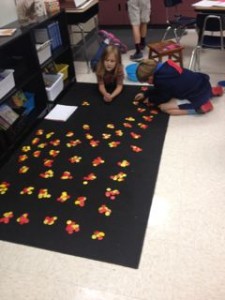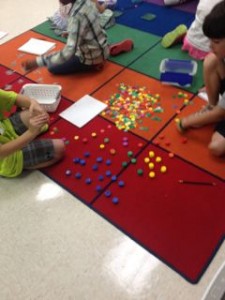The power of counting collections
I recently attended 3 days of district professional development on math. I learned tons but I want to write about one activity that I reached all my students and also provided valuable insights into my students’ mathematical understanding.
We read this article on Counting Collections. After reading this article, I was intrigued and wanted to try it with my students. Most elementary classrooms have materials on hand to do a counting collection activity. I went through all my math manipulatives and also pulled out school supplies that I had in the cabinet. I used the following materials: dominoes, counting bears, interlocking cubes, 2 sided-counters, paperclips, game tokens, beads, pattern blocks, and craft sticks. I had several different types of game tokens and beads. I had 12 different collections. They were going to work in pairs and I wanted all pairs to have many collections to choose from.
What I didn’t realize was how much this activity would show me. I expected most of the pairs to automatically count the objects by tens. I thought some might even count by 20’s. As I walked around observing students, many pairs counted by ones. BY ONES!!! I did have pairs organize in fives and tens but not as many as I thought I would have. I was also amazed that some groups decided to organize by other attributes such as color. So they would have piles of 8, 11, 4, 6, 15. When I asked them how many they had counted so far, they realized it was difficult to add them but continued with this strategy. I also saw strong math students struggle keeping up counting by 2’s past 32. They were GREAT until around 30 but then they would skip numbers. They would say, “30, 32, 36, 38….time passed…40, 42” It was worse when they counted over 100.
I think kids need to count real objects more often. Students count a lot in kindergarten but then many move on. I found that many students were great until their collection went over 100. Then everything fell apart. This is caused from everyone stopping the count at 100 every time. How many times do we count to 100 by 2’s, 5’s, & 10’s but never go past it? Kids shout “100!” when they reach it because they think it ends it all. 🙂
If you would like to try a counting collection, I would make these suggestions:
- Read the article about counting collections.
- Gather lots of different collections so students have choices.
- Provide paper for students to record their work.
- Make a simple form to write observations. I had a form but needed a LOT more to record notes.
- DO NOT SUGGEST A WAY TO COUNT. In other words, do not say “What if you counted by tens?” You can ask “Could you try another way to count the objects?” But then walk away! Let them struggle a bit and think of a way to make the counting easier. You can ask them to walk around the room and ask other groups how they are counting if they are really stuck.
- Make large collections that will require more than one math session or counting time. One important part of the task is being able to organize what they have counted, record what they have counted and also what is left to count. I had plastic storage bags and sharpies out if they needed them. (The funny thing was many just made 2 bags: counted and uncounted but they didn’t record the number in each. The next day, they had to start ALL over but they didn’t make that mistake the next day.)
What do look for:
- How do they organize the counted and uncounted objects?
- Do they have a strategy to count? Did they make a plan?
- How are they counting? Is it random? Did they choose to count by 1’s, 2’s, 5’s, or 10’s? If they counted by 10’s how did they get to ten? Counting by 1’s, or 2’s to make 10?
- When you come by and ask them to count for you, can they each count the collection? I noticed some pairs had one student who could count the collection but the other student could not. When they finished counting, I asked them to rearrange with a different number (easier) to verify the total. This gave support to the one who struggled and stretched the other student to work with a different strategy.
- If they are counting by 1’s, interrupt them with questions about other things. Then ask them how many they have. Most of the time, they will forget because it is a not an organized plan and is a poor strategy for such a large number. Once you do that a few times, I ask “I am so sorry. I keep interrupting you. Could you organize these in a way so that if I come by, you can find your count again quickly?” They usually move to more efficient strategies.
- When they find a total, ask them to record how they counted and to show their count in some way. Then ask them to verify the total by counting in a different way. When I asked them if they would get a different answer, some said “Yes,” but most said, “It will look different but it will be the same number.”
- Just take time to sit and listen to them count. They will amaze you and you will also find gaps in their understanding. Many students struggled over 100, then again over 200. Most did well counting by 10’s but when they had to verify the total by counting by a different number, I discovered areas we needed to work on. I don’t think we do enough of just sitting and listening to our students. You need to ask lots of questions. 🙂
- Some questions: How are you counting your collection? Why did you choose that strategy? How many do you have now? Looking at how many you have left, what do you think the total will be? Do you think it will be over ____? How are you going to show what you have done so far on your paper? Can you make it clear to anyone how you counted your collection?
Here are some pictures from our first counting collection activity. My students LOVED it. One day we had inside recess and I gave them tons of choices. They ALL chose counting collections. I was amazed. 🙂
Check out this article about counting circles in middle school. It is another math routine involving counting. It just shows that counting is powerful and important at any level!





